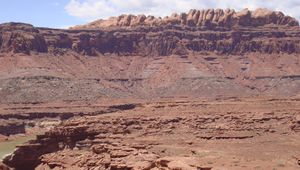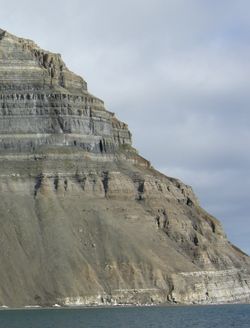قانون التراكب
| جزء من سلسلة عن |
| الجيولوجيا |
|---|
 |
قانون التراكب أو قانون/قاعدة التعاقب الطبقي Law of superposition تنص على أنه في أي تتابع طبقي تكون الطبقات الأقدم لأسفل والأحدث لأعلى، ما لم تتعرض لتأثيرات تركيبية.[1] In its plainest form, it states that in undeformed stratigraphic sequences, the oldest strata will lie at the bottom of the sequence, while newer material stacks upon the surface to form new deposits over time. This is paramount to stratigraphic dating, which requires a set of assumptions, including that the law of superposition holds true and that an object cannot be older than the materials of which it is composed. To illustrate the practical applications of superposition in scientific inquiry, sedimentary rock that has not been deformed by more than 90° will exhibit the oldest layers on the bottom, thus enabling paleontologists and paleobotanists to identify the relative ages of any fossils found within the strata, with the remains of the most archaic lifeforms confined to the lowest. These findings can inform the community on the fossil record covering the relevant strata, to determine which species coexisted temporally and which species existed successively in perhaps an evolutionarily or phylogenetically relevant way.
التاريخ
قانون التراكب اقترحه لأول مرة في 1669 العالم الدنماركي نيكولاس ستنو، وقدّمه كأحد أطروحاته الرئيسية في عمله الرائد Dissertationis prodromus (1669).[2]
في أدبيات اللغة الإنجليزية، ذاع القانون على يد وليام "ستراتا" سميث، الذي استخدمه لينتج أول خريطة جيولوجية لبريطانيا.[3] فكان أول قوانين سميث، التي نـُشِرت رسمياً في كتاب Strata Identified by Fossils (1816–1819).
تطبيقات قاعدة التعاقب الطبقي

قاعدة التعاقب الطبقي بصيغته المعدلة على أساس الاعتبارات الأثرية
انظر أيضا
| أجزاء من (طبقات) الصخور في تتابع طبقي زمني | فترات الزمن في تأريخ الأرض | الملاحظات |
|---|---|---|
Eonothem |
4.5 بليون سنة أو أكثر | |
Erathem |
12 مليون ومئات الملايين من السنين | |
| عشرات الملايين من السنين | ||
| مليون سنة | ||
| أقل من العهد ولا يستخدم في المقياس الزمني ICS | ||
- قاعدة أفقية أصلية
- قاعدة الاستمرارية الأفقية
- قاعدة علاقات القطع المستعرض
- تتابع أحفوري
- علم طبقات الأرض
- الجيولوجيا البنيوية
- Harris matrix
- Stratification (archeology)
الهوامش، والروابط والمصادر
الهوامش
- ^ عبد الجليل هويدي، محمد أحمد هيكل (2004). أساسيات الجيولوجيا التاريخية. مكتبة الدار العربية للكتب.
- ^ David Thomas, Robert Kelly, Archaeology, p. 153, Cengage Learning, 2005 ISBN 0155058991.
- ^ Patrick Wyse Jackson, The Chronologers' Quest: The Search for the Age of the Earth, Cambridge University Press, 2006 ISBN 1139457578, pp.127-8.
- ^ International Commission on Stratigraphy. "International Stratigraphic Chart" (PDF). Retrieved 2009-09-25.
المصادر
- Hamblin, W.K. The Earth's Dynamic Systems, A Textbook in Physical Geology, by W. Kenneth Hamblin, BYU, Provo, UT, Illus. William L. Chesser, Dennis Tasa, (Burgess Publishing Company, Minneapolis, Minnesota), c 1978, pg. 115, "The Principle of Superposition and Original Horizontality;" pg. 116: The Principle of Faunal Succession, "The Principle of Crosscutting Relations;" pg 116-17: "The Principle of Inclusion," (as in the Steno discussion above).
- Principles of Archaeological Stratigraphy. 40 figs. 1 pl. 136 pp. London & New York: Academic Press. ISBN 0-12-326650-5


